Вы здесь
Toprak Kala fortress.
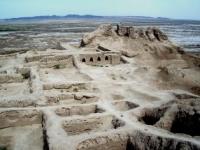
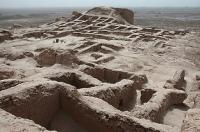
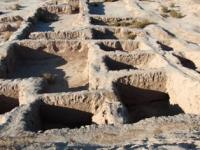
Recreational tourism in Uzbekistan.
"I am the last kagan of the Great Steppes,
There is neither a retinue nor troops, nor my yurt,
I alone doomed to chase through the ages.
I am descendants only in righteous dreams! ”
Ildar Nuraddin.
Excursion to fortress Toprak kala in Karakalpakstan.
Toprak-Kala Palace is located 212 meters west of the Nuku-Khorezm highway, 3.6 kilometers north and slightly west of Shark-Yulduzi village, 12.3 kilometers north-west of Bustan village and 26.9 kilometers to the north and slightly east of the village of Beruni in the Ellikala region of the Republic of Karakalpakstan.
In several kilometers from Urgench in a direction to the city of Khiva ancient site of ancient settlement Toprak Kalaa fortress, where in III - IV century н.э is located. The palace khorezmshahs settled down.
The Ancient fortress today represents a construction of the rectangular form which sizes make 350 × 500 meters.
Despite of numerous destructions, the height of walls of a fortress in separate places reaches almost ten meters. From all design only the southeast corner of a fortress was saved well enough, but even it allows to estimate all scale of the most ancient construction.
Just a few kilometers from Urgench, in the direction of the city of Khiva, is located the ancient city of Toprak Kala, where in the III - IV century AD The palace of Khorezmshahs was located. The ancient fortress today is a rectangular structure, the dimensions of which are 350 × 500 meters.
Despite numerous destructions, the height of the walls of the fortress in some places reaches almost ten meters. Of the entire structure, only the southeast corner of the fortress has been preserved quite well, but even this allows us to appreciate the entire scale of the oldest structure.
It was opened in 1938 by S.P. Tolstov. In 1940, reconnaissance work was carried out on the settlement: a large stratigraphic pit was laid in the south-eastern part of the city, its plan was drawn up, and lifting material was assembled. In 1950, a small excavation was laid on the western fortress wall.
Then came a break in the work on the monument, which resumed only in 1965 and with a three-year break lasted until 1975. The settlement of Toprak-Kala occupies an area of 500 x 350 m. Rectangular in plan, it is surrounded by fortress walls, preserved in the form of a shaft, sometimes reaching 8 - 9 meters in height.
The walls are equipped with numerous quadrangular towers with rounded corners and circled by a wide moat. It is established that the fortifications of the city have undergone a significant restructuring. Originally, it was a serf system with a two-story corridor with a vaulted lower floor and arrow-shaped loopholes in the upper one.
The external facade of the fortress wall was decorated with paddles and niches between them. After the restructuring, the lower floor of the corridor was laid with bricks and turned into a six-meter high basement, into which the early towers were also bricked up. Instead of the former arrow-shaped loopholes in the walls of the now one-story rifle gallery, flat-cut slit-shaped panels appeared, the wall with niches and vanes became the inside of a new rifle gallery.
New towers had a semicircular shape. In the middle of the southern fortress wall was the entrance to the settlement, decorated in the form of a complex pre-gate structure, also rebuilt. From it, across the city to the citadel, located in the northwestern corner of the settlement, was a central street about 9 m wide.
It divided the city into two halves, each of which, in turn, was divided by side streets 4.5 m wide by 5 quadrangular quarters with dimensions of 100 x 40 m. Excavations were conducted on the area of two quarters designated by the letters A and B, located in the western half of the city.
The layers relating to the II – VI centuries AD are revealed, however, judging by the presence of a certain type of Khorezmian coinage and ceramics, there should be earlier layers in the settlement. Three horizons are distinguished in the stratigraphic strata of the site. Top, fourth, not preserved.
It has been established that one of the quarters, A, was occupied entirely by temple buildings traditionally built here throughout the history of the city. The entire temple site was 42 x 42 m in size. Inside it were open three buildings constructed according to the same plan: a chain of rooms with wooden sills and door frames stretched from west to east was reproduced.
One of them - a large building I, measuring 35 x 18 m, facing the street between quarters A and B, consisted of three vast rooms 11 x 4 m. Its thickness reached 3 m. In the frontal, western and, apparently, the most important indoors in one of the walls was a pivot niche and other architectural features; it was a temple of fire.
In another building, called Building II, were found decorated with bronze gold-plated bracelets-clips, the horns of a ram’s argali, around which numerous offerings lay on the floor - fragments and whole glass vessels, ornaments / beads, pendants, rings, etc.
A fragment of alabaster painted sculpture depicting a man, fragments of gold foil, etc. was also found. Both buildings date back to the IVth - VIth centuries, but building II refers to a later period within a specified period of time. In the residential quarter, a multi-room residential array was opened, which included living rooms, storerooms, courtyards, etc.
Traces of handicrafts were recorded in the rooms facing the side and central streets. In particular, in the early period of the city, there were workshops / or workshop / for the manufacture of bows. As a result of the excavations at the site, a diverse and rich material was obtained, which allows to describe in detail the still little studied Kushan-Afrihid culture of ancient Khorezm, as well as important information on the history of the ancient cities of Khorezm.
The main array of the palace is built on a base of mud bricks, against which the northern and western city walls rest. It had the shape of a truncated pyramid with a height of 14.3 m with a surface area of 80 x 80 m. Soon, three additional arrays were added on higher pedestals up to 25 m; their area is 35 x 35 m, 40 x 35 m, 35 x 20 m.
The outer walls of the original part of the palace are 1.5 m away from the edge of the platform. They are washed away for a considerable distance, but where additional arrays adjoin, they were preserved to a height of up to 7.5 m before the destruction, probably not less than 9 m.
The facades were decorated with a system of vertical projections and niches, covered with alabaster whitewash. The entrance was on the east side, along open stairs around the entrance tower. Partially survived about 100 rooms of the first floor of the central array and several rooms of the second floor.
The walls of the premises were preserved to the full height in the peripheral areas, covered with attached pedestals, but strongly washed away in the central part of the site. The overlaps were applied vaulted (usually from trapezoidal raw bricks / and flat beams). In large rooms, beams leaned on wooden columns with stone bases.
In the internal planning of the palace, the division into three main complexes, almost isolated from each other, is noticeable. The southeastern side of the palace was occupied by a complex of 12 unadorned rooms, where vessels for ablutions, remains of a palace archive, and an armory were found.
Along the southern edge of the palace, near a long corridor, separated by a wall of burnt bricks, there were 4 blocks of the same type from two rooms and a staircase leading up. The corridor led to a small courtyard with round niches, around which four two-chamber shrines were grouped with pierced altars and niches.
In one of them, murals with a mourning scene survived. This suggests that the sanctuary was intended for a memorial cult, performed by the priests, whose dwellings were connected to the corridor. Most of the palace was occupied by a complex of ceremonial rooms and shrines associated with various aspects of the royal cultures.
The walls were decorated with paintings, and in five rooms - clay polychrome bas-reliefs. As a rule, only a small part of the former decoration that which was saved during the excavations of the 40s has reached us, is now in the State Hermitage Museum.
However, you can imagine the design and presumably determine the purpose of several premises. The “Hall of Kings” at the Toprak Kala Fortress is a dynastic sanctuary in which fire was burning on the altar in front of large images of the 23 kings of Khorezm unlike others, these sculptures are full-sized.
They were located on the Sufah, divided by partitions into a number of boxes. In each of them, in addition to the statue of the king, there were two female and one male high-relief images. “Hall of victories” on the fortress Toprak Kala - on our walls are bas-reliefs of seated kings and goddesses hovering beside them.
These compositions / survived only the feet of the figures, apparently, resembled images on coins, conveying the moment of handing the signs of royal dignity to the rulers. “Hall of dark warriors” at Toprak Kala fortress. Here, bas-relief images of kings, which stood in niches, were located under clay moldings in the form of huge stylized ram horns.
Dark-skinned warriors / the location of these small figures is impossible to establish trumpeted the glory of the kings. The design of the sanctuary room was apparently subordinated to the idea of military glory and good luck.
The “Hall of Deer” at the Toprak Kala Fortress was decorated with the figures of these animals, over which was a belt depicting griffins. Among other bas-relief fragments are pomegranate fruits, vines, etc. The decoration probably transferred the circulation of the life of the kingdom of plants and animals.
The “Hall of Dancing Masks” at the fortress Toprak Kala partially preserved on the walls images of dancing men and women. In the main niche, apparently, there was an image of a great goddess with a predatory beast / some fragments were found.
In two other large niches, there may have been satellite gods. The podium of the altar is open in the center of the hall. The hall, as one may think, was intended to complete the mysteries that symbolized the king's connection with the fruiting forces of nature.
Of particular importance is the significance of this sanctuary that it was directly connected to the main part of the throne ensemble. This ensemble consisted of the front yard and the aivan, divided by a three-arch portal. Under the central arch, the diagonals of the square intersected; This ensemble consisted of the front yard and the aivan, divided by a three-arch portal. Under the central arch, the diagonals of the square intersected in which the entire main palace is inscribed.
The northwestern additional array enclosed a large square room, now almost completely washed away. It was covered with corridors, on the walls of which waves and fish were depicted. Perhaps there was a sanctuary dedicated to the water element in the northwestern massif.
The southern massif also had a ceremonial, and, possibly, cult purpose. Found traces of painting and the remains of a rectangular podium in the axial room. The northeastern array consisted of 8 very high long rooms, covered with arches several arcs of one of them miraculously held to our days.
The purpose of these, not decorated with anything and soon after the construction of the pledged rooms, remains unclear. The most important find found in the palace is the ancient Khorezm documents. Receipts of various things and products were recorded on the skin; several dates have survived, the extreme of which was 188 and 252 years of the Khorezmian era.
Its beginning lies within the first half of the 1st century AD.
Documents on the tree are lists of able-bodied or combat-ready free men and slaves who were part of several Khorezmian surnames. The palace, which had a sacred purpose first of all, was emptied at the beginning of the 4th century AD, and then after partial repair was used as a city citadel.
Most household finds belong to this period. As studies of the northern complex of Toprak-kala from 1976 to 1979 showed, this is a group of buildings located outside the settlement of Toprak-kala about 100 m north of the palace excavated by S. T. Tolstoy in 1946-1950. and additionally investigated in 1967 - 1972.
The buildings of the Northern complex can be traced on a site of about 12 hectares. The length of the chain of buildings stretches along the north-south axis - 350 m. The same length of the array, oriented in the latitudinal direction.
Now there are 10 buildings, but the number is conditional. It is likely to decrease, since as a result of the excavations, there has been a tendency to unite individual hills into very large palace-type buildings. Near to the “high palace” building of the northern complex number 1, dug all the years 1976 1979. and located along the west-east axis.
The dimensions of the building are determined by the area of the basement, approximately 160 - 180 x 50 m, whose height reaches about 2.5 m. About 50 rooms have been cleared here, which are large halls of the palace type, as well as small utility rooms.
Halls and small rooms had murals on the walls. However, few survived. In one room dominated by colored ornaments on a white and black background. Large and small rosettes, lotus flowers, tulips, creepers, etc. were depicted.
In another room, the ornaments had a completely different character, imitating geometric patterns of fabrics or carpets / the image of the fringe was also preserved. In the third room of a large hall on the walls are preserved clay strips, forming a rhombic grid. In another hall were found the remains of a sculpture, unfortunately, only fragments depicting lower legs and dresses.
Here, in this hall, a large / 0.70х0.70 m / piece of gray marble with well-polished sides / 0.2 m / and with a top down was found. This is either part of the sculpture, or the podium under the altar. Thus, it is a palace complex.
Were here and business premises - the eastern part of the building, but they are poorly preserved. A part of the premises with holes for vessels, ashes, garbage and foci remained. In the second building, preserved in dimensions of 70 x 35 m at a height of 1.2 m, 25 rooms were cleared.
There are also halls and small rooms. Here in most rooms the walls are covered with white plaster. However, there are also fragments of colored painting of various colors / red, pink, blue, gray /. Here, as well as in the first building, several halls with wooden bases were found.
Preserved in place of the base of columns from polymitic sandstone, which has the form of a three-stage plinth, deeply traditional to the architecture of that time, on which the second part of the pot-shaped form was installed. Potted parts were dropped from skirtings.
There are a number of large halls in which there are no bases for columns. Apparently, these were open spaces. In one of the halls there is a painting of floral and geometric ornaments as a backing under the floor of the room. This suggests a possible restructuring of the palace.
At the northern wall of the second building there are two towers No. 1 and 2, which are rectangular monolithic plinths of some un-preserved structures. Their appointment is unclear. Fortification values can be assumed if the yard can be proved from the east side.
From the west from buildings No. 1 and No. 2 in the meridional direction there is building No. 7 with dimensions of about 100 x 30 m and a height in the southern part from 10 to 150 cm and the northern one - up to 5.5 m. More than 50 rooms have been cleared in it.
In the southern part we have three three-room complexes, very similar to the complexes in the south-western part of the “tall palace”. In the northern part of the lower rooms were laid with bricks. Two stairs led to the second floor. Thick walls and laid konaty kept the bottom floor to our time.
In one of the pits, it was found that the basement of building 7 stands on the mainland, whereas the basement of building No. 2 at the junction is underlain by a cultural layer of about 30 cm. From this it follows that building No. 2 is built later than building 7.
It is thought that building No. 1 , № 3, № 7, were built at the same time, since they had the same basement up to 2.5 m, and building number 2 - a little later. In addition to the basement of the building number 3 nothing has been preserved. It was built 80 m east of building number 7 and 8-10 m north of building number 2.
Buildings 4, 5, 6 are elongated in the meridional direction to the north of building 3. They also left only the basement rooms. Between buildings Nos. 7 and 2, as well as 3, the northern courtyard of the complex is located. West of building number 7, long and narrow buildings number 8, 9, 10 are stretched out in the latitudinal direction.
Courts are located between buildings number number 8, 9, and 10; and, finally, further to the west there is a shaft of a cover complex, where two Huvishka coins were found. In addition, a coin was found on the floor of room No. 24 of building No. 1 in 1978, which dates back to the time of Wima-Kadfiza.
In the passage to room No. 24, a small golden head of a lion cub was found 3x2.5 cm. In room No. 3 of building No. 1, an alabaster form was found for making a bas-relief image of “satire”.
Geographic coordinates of the Toprak-kala fortress: N41 ° 55'37.89 "E60 ° 49'24.56"
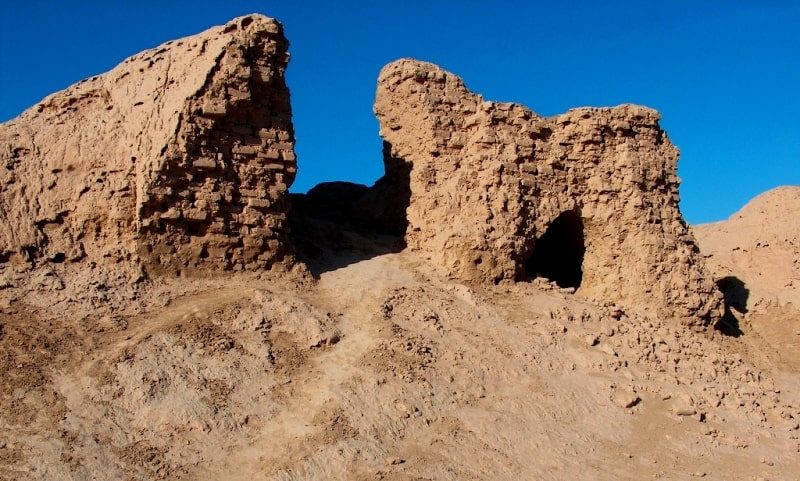
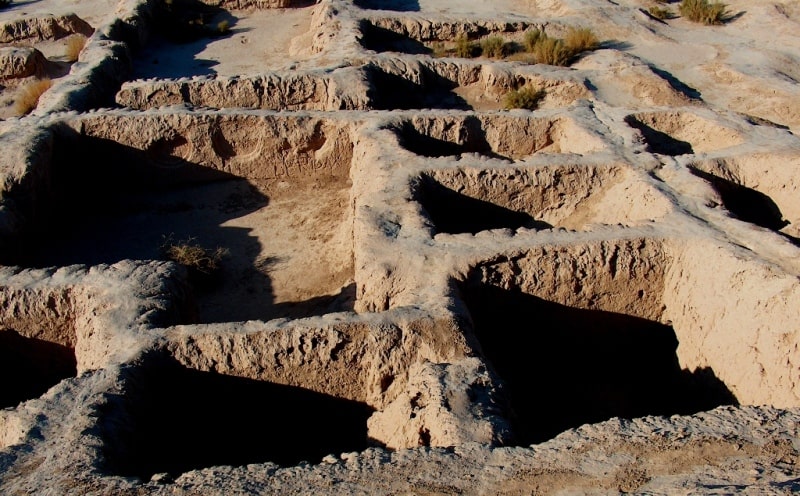
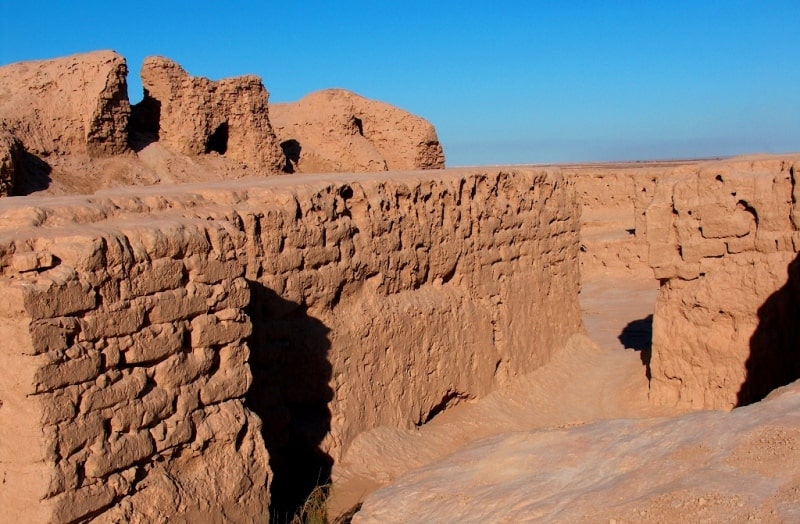

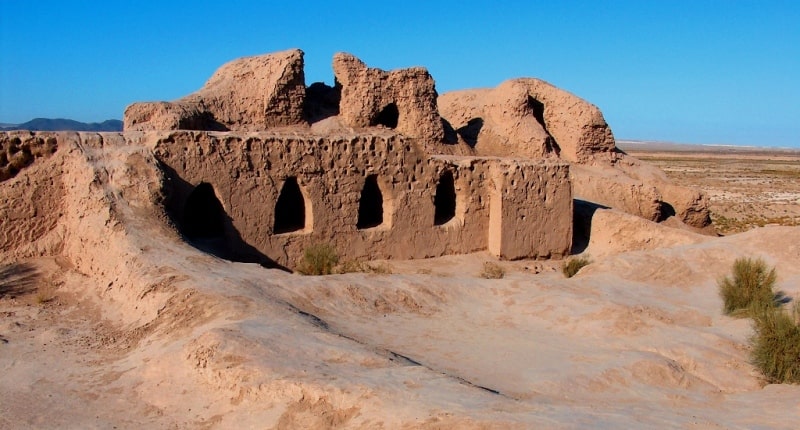
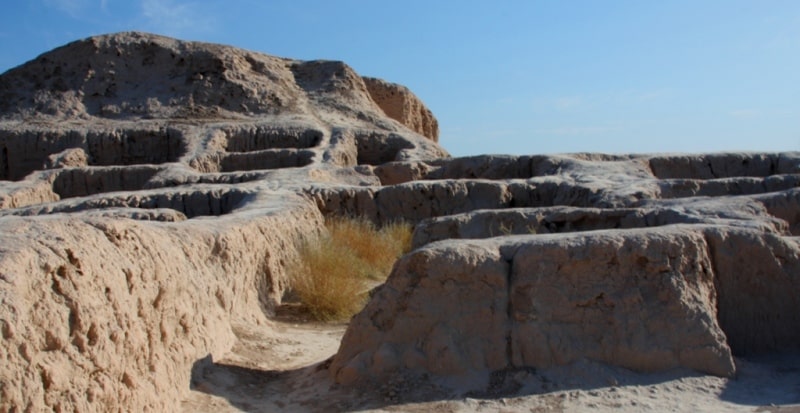
Authority:
52. Yu.A. Rapoport, A.N. Gertman Works on Topkar-Kala. - AO - 1976. M., 1977. 53. Yu.A. Rapoport Some results of the study of the palace in the site Toprak-Kala. - In book: Culture and art of Khorezm. M., 1980. 63. Tolstov S.P. Ancient Khorezm. M., 1948. 64. Tolstov S.P. In the footsteps of ancient civilian civilization. M. - L., 1948
Photos by
Alexander Petrov.







